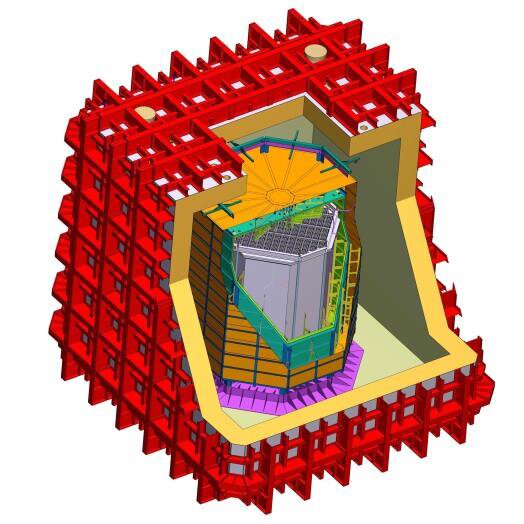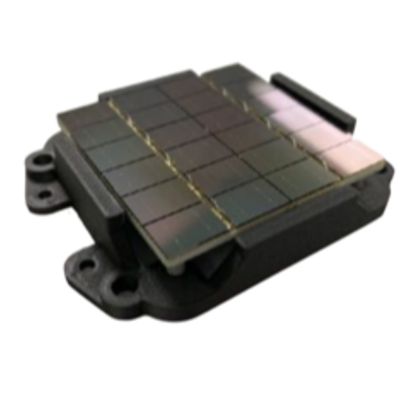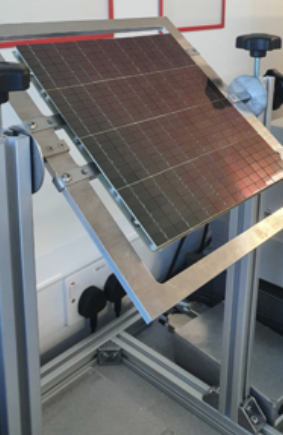DarkSide-20K is a dark matter detector sensitive to a wide range of dark matter candidates, from keV-scale warm sterile neutrino dark matter to GeV-scale light dark matter candidates to 100-10,000 GeV-scale Weakly Interactive Massive Particles (WIMPs), to heavy dark matter candidates up to Planck-scale masses. The Global Argon Dark Matter Collaboration (GADMC) is currently constructing DarkSide-20K deep underground at the Gran Sasso National Laboratory (LNGS).
DarkSide-20k seeks to detect dark matter interactions in a time projection chamber detector filled with ultra-pure liquid argon (LAr) from deep underground. A dark matter particle colliding with a LAr atom in the detector would transfer a small amount of energy to the atom, which would recoil depositing that energy. This recoil leads to two detectable processes: ionisation and excitation of the surrounding LAr atoms, producing free charge and scintillation photons respectively. The photons are detected directly, in a signal termed S1, while the free charges are drifted in the electric field of the time projection chamber to a gas region at the top, where a proportional secondary photon signal is produced, termed S2. The photon signals from both the S1 and S2 mechanisms are detected in novel, large-area photon sensors employing silicon photomultiplier (SiPM) technology. The relative intensity and timing distribution of the S1 and S2 signals provides critical information about the candidate dark matter interaction, such as its energy, position in the detector, and particle identification.
The Global Argon Dark Matter Collaboration has gone to extraordinary lengths to minimise sources of backgrounds to the dark matter search. In the predecessor DarkSide-50 experiment, the collaboration demonstrated that argon extracted from underground sources is more than a factor of 1000 lower in radioactivity than conventional argon extracted from the atmosphere. The predecessor DEAP-3600 experiment demonstrated radon suppression at the level of less than 200 radon atoms per tonne of liquid argon target. For DarkSide-20k, the collaboration developed SiPM-based sensors with more than a factor of 3 higher photon detection efficiency, 10 times lower radioactivity, and 50 times lower noise than conventional Photomultiplier Tube photon sensors used in the predecessor experiments. Thanks to its innovative experimental design, advanced technology and precautions taken to minimise all sources of background, the DarkSide-20k experiment will reach for beyond the current world leading constraints on dark matter candidates from the predecessor DarkSide-50 experiment for light dark matter, the predecessor DEAP-3600 experiment for ultra-heavy dark matter, and will extend the sensitivity in the WIMP mass range beyond the projected reach of any experiment operating today.
The Darkside-20K detector consists of the time projection chamber detector, with an active target mass of 51 tonnes of underground argon, surrounded by an inner veto detector with a mass of 35 tonnes of underground argon, inside of an outer veto detector with a mass of 700 tonnes of atmospheric liquid argon. This whole assembly is housed inside a membrane cryostat, using the technology originally developed for transport of liquified natural gas in ships and adapted for use in the DUNE experiment.


![]()
Left: 3D rendering of DarkSide-20K: the heart of the dark matter detector is the LAr Time Projection Chamber, surrounded by inner and outer veto detectors inside the membrate cryostat. Right: UK Ambassador to Italy visiting the DarkSide-20k detector underground in LNGS Hall C, on a tour with PPD staff member and UK Principal Investigator J. Monroe.
With this detector, the collaboration aims to achieve <0.1 instrumental background interactions to the dark matter search in an exposure of 200 tonne-years. This critical ‘ultra-low background’ benchmark enables dark matter search sensitivity to a broad range of dark matter candidates, deep into un-explored parameter space, with outstanding potential for discovery. Additionally, with its highly sensitive instrumentation, DarkSide-20k will detect tens of thousands of low-energy solar neutrino interactions, improving our knowledge of how stars burn. The experiment can observe atmospheric neutrinos, detecting hundreds of neutrino interactions from a galactic supernova, helping to understand how supernovae produce heavy elements.
Darkside–20K is instrumented with 28 m^2 of Silicon PhotoMultiplier (SiPMs) array detectors. SiPMs use semiconductor technology to detect photons with 3x the efficiency of their predecessor sensors, termed PMTs, thanks to their enhanced quantum efficiency.
The UK is producing 25% of the SiPM readout array, to instrument the veto photon detection system – comprising more than 50,000 silicon photomultiplier sensors. A key challenge is to group the SiPMs into arrays to minimise the number of readout channels, and this is done by grouping sensors into 24 SiPM “tiles” with a single output channel, and then further into 16 tile “photon detector modules” with four output channels – ultimately summing the signals from 96 SiPMs, covering an area of 10 cm x 10 cm, into a single data acquisition system channel, all whilst preserving single photon counting resolution. PPD are working alongside as part of a team of 10 UK institutes producing and testing this novel photon detection system.
Using the R115 cleanroom produce SiPM array detectors, PPD and TD staff are working together to produce and qualify these detectors for physics operations, ensuring they are performing as expected. With this ambitious project PPD will develop expertise within SiPM R&D, towards future large-scale SiPM deployments within the LHCb


Left: the starting point of detector production in the UK: an 8” wafer of SiPMs. Center: an assembled ”tile” of 24 SiPMs. Right: An assembled ”photon detector unit” of 384 SiPMs, with four readout channels.
The production of SiPMs detectors in the UK is on schedule, with the UK’s contributions to be installed over 2025-26, for a decade of DarkSide-20k data taking from 2027.
